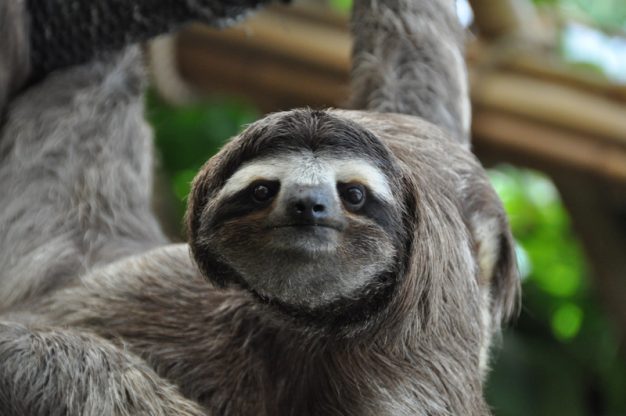
You’re commuting to Stony Brook. You’re 20 minutes away, and it’s the first thing you see if you’re driving down Route 454: Sloth Encounters. At first glance, it seems like something interesting that you’d take your kids to see. What could possibly be malicious about a petting zoo for sloths?
According to News 12, owner Larry Wallach claims that the sloths are properly cared for. However, after watching a YouTube video, I came to realize that the conditions were very tightly-packed and unsurprisingly, man-made. There are unnatural placements of branches, leaves and vines to simulate what living in the wild is like. It’s overtly disrespectful to wildlife itself and to the sloths who were ripped away from their natural habitats.
Sloth Encounters was ordered to temporarily close on Sept. 15 due to being ticketed with the possession of wild animals, which violates the code of the Town of Islip. Ever since the temporary shut down of his business, Wallach moved towards home visits for sloths. In a more recent infraction, he was cited by the United States Department of Agriculture for keeping a sloth and wallaby in unsafe conditions at his East Rockaway home — all the more reason to believe he could care less about them and is doing it just for show.
To what extent is it okay to pull a wild animal from their habitat? In what world is it okay to chain down and restrict a wild animal? What these animals actually need is the ability to move, a habitat with lots of trees, natural sunlight and, in general, nature itself. Surviving is having a home, food and water. Thriving is one step ahead of surviving; it is having basic necessities and enrichment. The animal’s life is enriched if their mental and physical needs are met, which will allow them to flourish. It is one thing to give an animal their food and water; it is another thing to actually provide an environment for an animal to thrive in. How are these wild animals supposed to thrive in the small environment they are confined to?
According to National Geographic, sloths sleep for about 15 to 20 hours a day. Even when they’re awake, they remain motionless. Sloths are also largely nocturnal; they forage for food during the night time. The Smithsonian National Zoo states that sloths spend most of their time hanging or curled up on a branch. Sloths typically live in tropical rainforests — large areas with a huge biodiversity, whether it be plant-life, bugs or other animals in the ecosystem. Sloth Encounters does not provide this environment in the slightest.
There are a lot of other issues with the idea of Sloth Encounters, one of them being that Sloth Encounters is for-profit, while most of the recognized zoos in New York operate their own non-profit research organizations. This means that the proceeds from Sloth Encounters go straight to Wallach’s pockets instead of to the many programs that aim for the conservation of wildlife. As if that was not enough dirt on Sloth Encounters, it gets worse when it comes to the mastermind of it all, Larry Wallach. He’s not alien to the idea of exotic animals, and he’s been a handler for years, mistreating his animals for just as long.
According to the 2002 BBC News article “Big cats cause stir in the U.S.,” Wallach was planning on surrendering his Bengal tiger because it had gotten too big to fit in his backyard. His eyes were set on finding another baby tiger to harbor.
“I think if you’re capable financially, property wise, and you want it — we’re Americans, we live in a free country — then go get it!” Wallach said. This alone should show how careless Wallach is. He truly believes that just because someone has money and is an American, they should set out and get whatever they want, regardless of the consequences.
On his business page, Wallach shows exactly how he views these sloths.
“We have one sloth, included in the 7 that is a rescue from the wild. He was illegally taken from the wild and he is currently being housed here and is adapting very well to his new habitat with his new brothers and sisters.”
After moving on from his adventures of being an exotic tiger owner, he moved over to sloths, where there is more gray area legally in order to keep them. It is a blatant display of ignorance on Wallach’s part, from the humane treatment of wildlife, and the desire to keep up his shameful antics of taking wildlife and trying to domesticate it.












